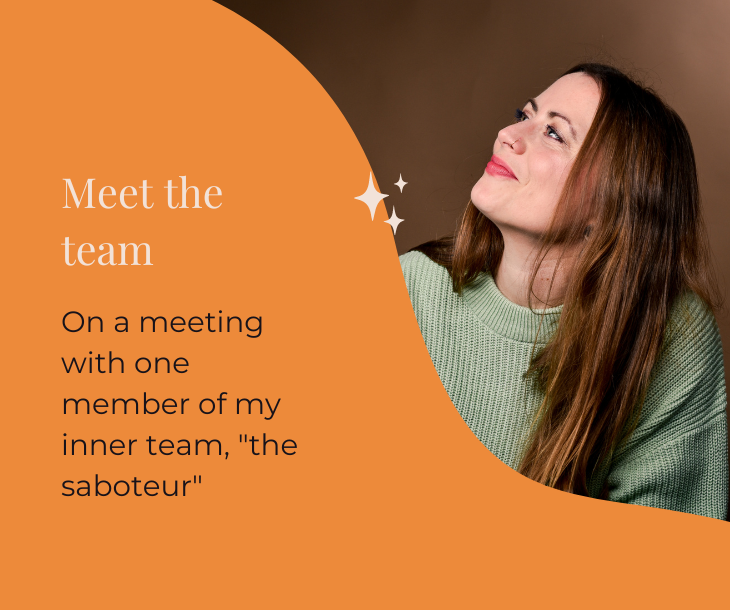BLOG
Reclaim your voice – both inside and outside.

#4 | Meet the team: On a meeting with one member of my inner team, "the saboteur"
It felt like I was building a wall for my house, and as soon as the solid ground was laid, someone came and knocked it over. Yes, I managed to build things, but it felt so exhausting, and it became clearer and clearer that I was sabotaging myself.
Introduction: Discovering my inner saboteur
In the last month or even years, I noticed a pattern: whenever I worked on something in my business, usually quite hard and disciplined, and it was starting to grow and get bigger, there almost always came this point of "letting go." There is not even another word to describe it. Whereas only a few weeks before I was motivated and full of energy, as soon as the first results showed, I somehow became tired, lost motivation, and didn't see the sense in what I was doing anymore.
It felt like I was building a wall for my house, and as soon as the solid ground was laid, someone came and knocked it over. Yes, I managed to build things, but it felt so exhausting, and it became clearer and clearer that I was sabotaging myself.
Why did that happen?
I knew I had quite a few limiting beliefs around the topic work, like: "Someone like me cannot be successful" or "I will hurt someone else if I am successful."
To go deeper into that is material for another time, though. I rather wanted to get to know my inner saboteur, the part of myself that was always trying to keep me from growing.
In this blog post I will take you with me to a meeting with one member of my inner team. I call it "my inner saboteur."
Table of contents:
Introduction: Discovering my inner saboteur
Understanding the inner team concept
Meeting my "inner saboteur"
Transforming the saboteur's role
Reflecting on the journey from a higher perspective
Conclusion: Embracing the inner dialogue
1. Understanding the inner team concept
To give you a quick overview: The "inner team" model, developed by Friedemann Schulz von Thun, is a psychological tool that helps individuals understand and manage their inner world by recognizing the multiple internal parts or members within them. By identifying and listening to these voices, individuals can resolve inner conflicts and achieve better self-awareness. This model is used in personal development, coaching, and therapy.
In this blog post, I will take you on an imaginary journey to my inner team to meet one of the members, the "inner saboteur".
Note: The work with my "inner team" is purely imaginative, a mental tool for enhancing motivation and self-awareness.
2. Meeting my "inner saboteur"
How would I feel without the saboteur?
To first identify the part, that was holding me back, the first thing I did was imagine how I would feel without this sabotaging mechanism. So I imagined myself working on my projects without this feeling of frustration and tiredness. And it was such a big relief! It felt just great – easy and light. All the self-doubts would be gone. In this state I thought that everything was possible.
Identifying the part of the team that's causing the trouble
So I turned to the other part of my inner team, the one that for me caused me stop my projects and was responsible for losing my motivation. To have a good safety distance, I imagined placing it to the other side of the room, so I could look at it without being disturbed.
And there it was – I suddenly imagined this small, scraggy figure with white fur. The expression on his face was very sad. At the same time I saw this big question mark in his eyes.
And I suddenly thought that this little saboteur had no idea what it was doing wrong. It was just doing what it had always been doing and what it had learned to do. It had no idea that it was hurting me with that. And I noticed, my impulse was not to get rid of it. I felt sorry for this little being that obviously tried to do everything right, but it could never satisfy me.
3. Transforming the saboteur's role
Getting into a conversation
So I tried to start a conversation. But when I was trying to talk to him, he was only looking at me with big eyes and moving his shoulders. But when I asked, if it would rather work on something that would also make me happy, a big smile on his face appeared. I took that as a yes and knew that I had to find a new for the "inner saboteur".
Finding a new tole
I asked him if it would not rather work with me together, supporting me to build the wall instead of tearing it down and I was happy, because I received a very clear "yes".
Working together instead of against each other
At the moment, I'm working side by side with my inner team. When the old feeling of "giving up" appears, I imagine my inner saboteur diligently continuing to build, brick by brick. This mental exercise, using the "inner team" as an imaginative model for self-motivation, gives me energy and drives me forward. I can see the wall getting higher and higher, a testament to our collective effort. It seems we've struck a good deal, and I feel much more supported and resilient as a result.
4. Reflecting on the journey from a higher perspective
Returning from my imaginative journey and reflecting on it from a higher perspective, I recognize that the "inner saboteur" is a part of me deeply tied to my limiting beliefs and this process won't transform my core beliefs overnight. However, visualization provides a concrete anchor, fostering greater awareness and compassion for what holds me back. The image of this team member happily building my wall brings me motivation and joy.
In the future, if I notice these old patterns returning, I will go through the process. This helps me embody more and more the newfound sense of support. That, for me, is the wonderful aspect of the inner team.
5. Steps to engage with the inner team members
In the following, I will outline the steps that I took. This doesn't imply that it's the common or traditional way, or that you have to follow these exact steps. It simply shows how I progressed.
1. Imagine and feel the release
The first step I took was imagining and feeling what it would be like without the pattern of sabotaging what I had just built up. It brought a sense of release; physically, it felt like a weight had been lifted from my chest.
2. Create distance and visualize
After that, I took a good distance from the sabotaging feeling and placed it on the other side of the room. From this safe distance, I imagined how the saboteur could look like:
What is the size?
What is the color?
What is the expression towards me?
Does it have a name?
Does it have something in its hand?
Does it say something?
3. Identify the member
I gave myself a few minutes to identify my "inner saboteur", to really understand how I would feel towards it.
4. Start a conversation
I first welcomed it.
I thanked it for being so diligent in its own way.
Then I told it how it would make me feel and asked if it knew about that.
I expressed my wishes and told it what I actually needed from it.
I proposed a new role that was accepted
6. Conclusion: Embracing the inner dialogue
Sometimes, we discover that these inner parts, which we wish would go away, were actually working hard to protect us from something negative.
You might wonder, "But how do you imagine such a thing?" Usually, these images come straight from our gut feeling. In my coaching sessions, I'm often surprised by the pictures, symbols, and names that appear.
Working with our inner team happens in our imagination, but it can still have a big impact. It helps us see patterns, struggles, problems, or behaviors more clearly, and it allows us to safely face something that used to scare us.
This process gives us a chance and reminds us to find different ways to handle problems or react in certain situations. It also helps us become more aware of what's going on inside us and encourages us to explore new approaches.
☕️ I invite you to a Coffee Call
If you're interested in learning more about the inner team and working with me, I invite you to a free 20-minute coffee call. During this discovery call, we can discuss your goals and needs, how I can best support you, and how we can work together. To learn more about me, you can also sign up for my newsletter or connect with me on Instagram. I am excited to get to know you.

FREE DOWNLOAD
YOUR VOCAL DIARY
Are you struggling to maintain a consistent daily vocal practice routine?
The VOCAL DIARY is a guided Diary that I created to help establish a practice routine (that fits into your schedule). Get your Diary for one week for free.
Establish and nurture your practice and celebrate your progress. You got this!



